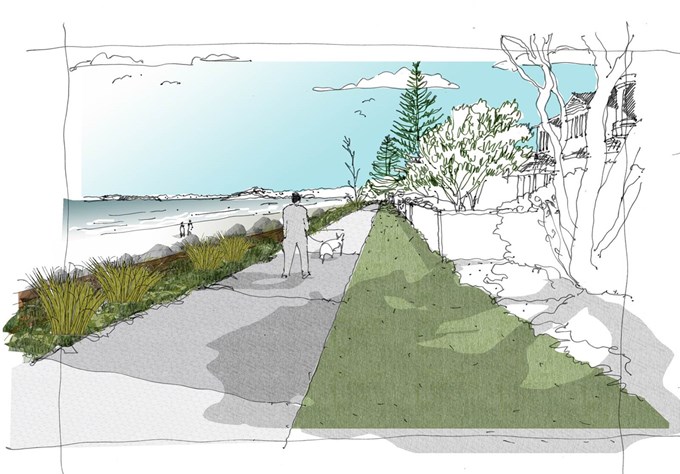Auckland Council is proposing a permanent seawall at the northern end of Ōrewa Beach between Kohu and Marine View streets.
Hibiscus and Bays Local Board has recently endorsed the seawall’s draft concept design which includes a 640 metre-long seawall and a walkway with four access ways to the beach.
Protection from storm damage
Hibiscus and Bays Local Board Chairperson Julia Parfitt says the northern area of the beach is the top priority.
“The proposed design will protect the northern end of the beach from further storm damage,” she says.
“There is a huge risk that we lose what’s left of Esplanade Reserve and if that happens people won’t be able to access this part of the beach at high tide.
“A seawall will safeguard the reserve; ensure public access to and along the beach’s northern end and protect legal easements that provide access to a few beachfront properties.”
Key points from the proposed seawall design:
- The 640 metre-long seawall will combine rock rip rap and rock masonry and will accommodate pedestrian access to and along the beach.
- A concrete path, about two metres wide, will be built behind the seawall. This path has been set as far seaward of private properties as possible.
- The seawall design can accommodate the related effects of climate change such as rising sea levels.
- Low level planting will be used to enhance the seawall, soften its edges and catch some of the wind-blown sand.
- Dunes will be restored along a section of the beach seaward of Kinloch Reserve.
Central Ōrewa Beach
Central Ōrewa Beach, around the Ōrewa Reserve area, is outside the scope of the seawall proposal.
Manager Local and Sports Parks North Martin van Jaarsveld says that the Ōrewa Reserve is being managed and monitored through the Ōrewa Beach Esplanade Enhancement Plan (OBEEP).
“We have divided the beach into zones based upon detailed analysis of beach profile monitoring data, previous investigations and a working knowledge of the beach,” he says.
“This helps us determine what work is most urgent and we can recommend the best treatment option for each part of the beach.
“We regularly transfer sand to the central section of the beach. Sand replenishment is well-used at many other beaches. It works well here as it creates a dry high tide area that beach goers enjoy using. The sand is also an early buffer for Ōrewa Reserve during storms.”
Julia Parfitt says that longer-term decisions will need to be made on how people would like to use Ōrewa Reserve and the surrounding beach.
“Options will be presented to the local board and community next year after the resource consent application is lodged for the beach’s northern end.”


